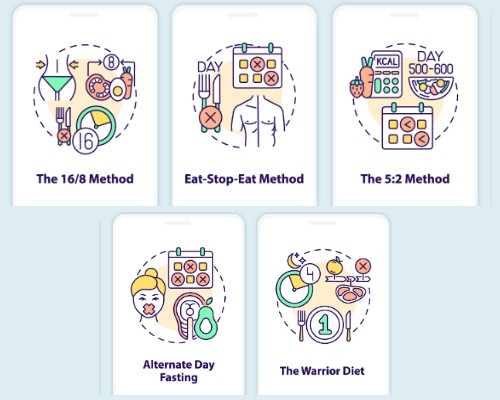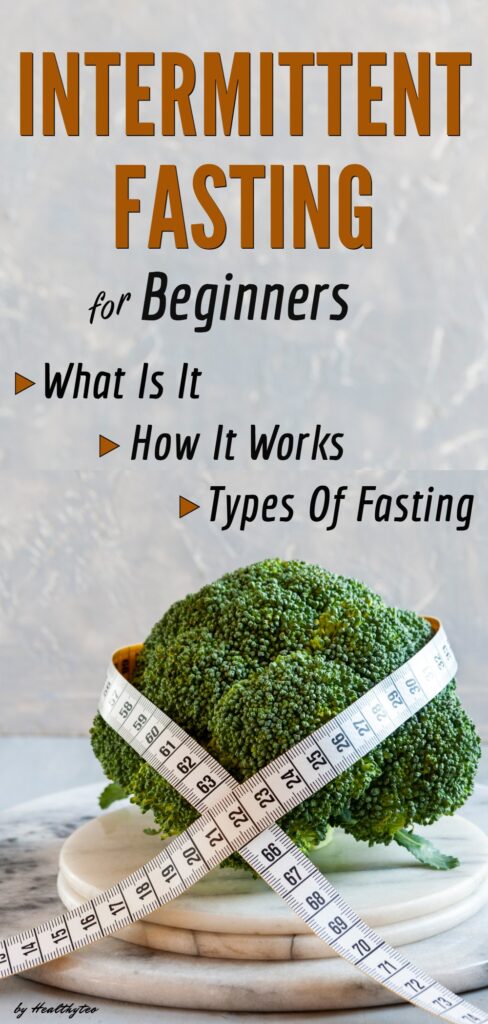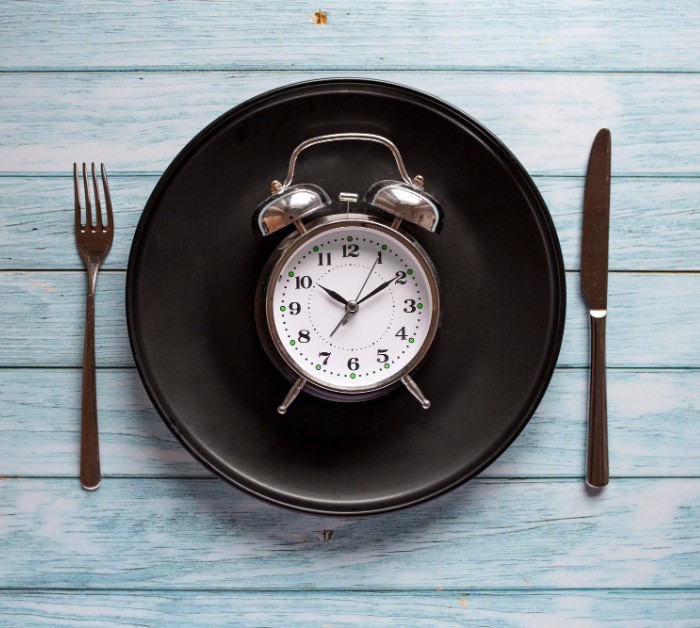Intermittent fasting for beginners: What is it, how it works, benefits and side effects
You’ve probably heard that people are using intermittent fasting to lose weight and improve their health. This eating pattern is not new, it’s something practiced by people from all around the world for a long long time.
If you are not familiar with intermittent fasting and how does it work, we will try to explain it in this article.
First, we must mention that fasting is not starvation, it is just avoidance of food for any period of time, from few hours or more. The period you’re not eating let’s say from dinner to breakfast the next day, approximately 12-14 hours you’re intermittent fasting.
Intermittent fasting is not something unusual, it’s part of everyday normal life. it’s the oldest and most powerful dietary intervention imaginable.
If you are a beginner in intermittent fasting here you will found what are the most popular ways of intermittent fasting, how to prepare yourself for fasting, how it works, and so much more.
What is intermittent fasting?
Intermittent fasting (IF) is not a diet, it is an eating pattern where the period of eating and the period of fasting (not eating) trade-off in shifts. It doesn’t change what you eat but instead, it changes when you eat.
In the past food wasn’t always readily available and wasn’t guaranteed, ancient hunter-gatherers didn’t have food stores, refrigerators, and food available every day. Sometimes they couldn’t find anything to eat.
Our bodies are actually very well adapted to fasting, humans evolved to be able to function without food for extended periods of time.
Fasting from time to time is more natural and less stressful on our bodies than many diets are. Today fasting is also practiced by many of the major religions in different forms with many people following them and feeling great.
Intermittent fasting is a popular method that people use to:
- lose weight
- simplify their life
- improve their overall health and well-being, such as minimizing the effects of aging
How does intermittent fasting work?
When you eat your body is processing the food that you’ve consumed for few hours, taking all the energy necessary from that food. When you’re not eating, fasting for a certain period of time your body doesn’t have this source of energy and has nothing to do but use the fat you have stored.
While you are fasting several things on cellular and molecular levels happen in your body. Your cells initiate an important repair process and change the expression of genes, while your body adjusts hormone levels to make stored body fat more accessible.
Changes that occur in your body when fasting
Insulin sensitivity improves and levels of insulin drop dramatically. Our bodies’ reaction to eating causes the production of insulin. The greater our sensitivity to insulin, the more efficiently we use the energy from our food.
After a period of fasting, we become the most sensitive to insulin. Lower insulin levels make stored body fat more accessible, this leads to weight loss and helps to build muscles.
Autophagy – when fasted your cells initiate the cellular repair process which includes autophagy, where cells digest and remove old and dysfunctional proteins that build up inside cells.
Here, you can find out more about autophagy, what is it and how to trigger autophagy for amazing health benefits.
Human growth hormone – the levels of HGH (human growth hormone) skyrocket increasing as much as fivefold. This has benefits for muscle gain and fat loss.
Gene expression – there are some changes in the function of genes related to protection against disease and longevity.
While practicing intermittent fasting your body moves through several phases of the fed-fast cycle, depending on the amount of time you fast (there are different types of intermittent fasting, that we will present you down in this article).
The different stages of fasting
There are several forms of intermittent fasting and most of them involve abstaining from food for periods of 16-24 hours at a time.
In all forms, your body moves through four phases: fed state, early fasting state, fasting state, and long-term fasting state.
Fed state
The fed state occurs during the first few hours after eating. During this period your blood sugar levels increase and higher amounts of insulin are secreted. Also, the levels of hormones like leptin and ghrelin, shift.
Leptin is a type of hormone which has an appetite-suppressing effect and is increased after eating. Ghrelin stimulates hunger and its levels decrease after you eat.
Good To Know
The fed-fast cycle resets back to the fed state as soon as the food is consumed during a fast. The size and composition of your food affect how long the fed state will remain active.
Early fasting state
A few hours, around 3-4 hours after eating your body transitions into an early fasting state which occurs when amino acids, fatty acids, and glycogen are converted into energy.
During the early fasting state, your blood sugar and insulin levels start to decline, causing your body to convert glycogen into sugar (glucose) to use as energy.
Toward the end of this phase, your body will slowly run out of liver glycogen stores and start searching for another energy source. This phase lasts until 18 hours after eating.
Fasting state
At this point, your body begins to break down protein and fat stores for energy. This results in the production of ketone bodies – a compound produced when your body converts fat into fuel.
In this phase, your body transits into ketosis – a metabolic state in which your body uses fat as the primary source of energy.
The size and composition of your last meal and overall diet along with individual differences affect how quickly you enter ketosis.
Some of the most common signs of ketosis are weight loss, decreased appetite, fruity-smelling breath, and increased levels of ketone bodies in the blood, breath, or urine.
Intermittent fasting and ketosis state
Some forms of intermittent fasting that have a shorter time range of fasting from 12-18 hours a day, may not reach this state. Ketosis may not be achieved with fasts lasting less than 24 hours.
Starvation state – Long term fasting state
The long-term fasting state or also called starvation state typically occurs around 48 hours after food intake. During this period insulin levels decrease, ketone levels increase and protein breakdown is reduced to conserve muscle tissue.
Must know about long-term fasting
Long-term fasts are not recommended for most people and should only be performed under medical supervision.
Each of these phases varies based on the primary source of energy used for the body and keep in mind that prolonged fasting should only be conducted under medical supervision.
Most popular ways to do intermittent fasting

Here are the most popular ways to do intermittent fasting. Every one of these methods can be effective, a person should pick one that suits their preferences and which they think they can stick with.
The 16/8 method
With the 16/8 method, your “eating window” lasts 8 hours during the day and the other 16 hours are used as fasting time. Within the eating window, you can fit in two, three, or more meals.
This method of intermittent fasting can actually be as simple as not eating anything after dinner and skipping breakfast. If you skip breakfast you can have your first meal at noon, followed by your last one by 8 pm. Or if you have your first meal at 9 in the morning you should stop eating at 5 pm.
You can choose your own time for eating/fasting, it is a simple 8 hours window for eating and 16 hours for fasting.
You can drink coffee, water, or other zero-calories beverages during the fast, which can help reduce feelings of hunger.
This cycle can be repeated as frequently as you like, from once or twice a week to every day depending on your personal preference. For women, it’s recommended to fast only for 14-15 hours because they seem to do better with slightly shorter fasts.
The 16/8 intermittent fasting
This method of IF is so popular among those looking to lose weight and burn fat. Most diets often set strict rules and regulations, while 16/8 intermittent fasting is easy to follow and can provide good results with minimal effort. This way of IF is the most effortless and is the most popular way of IF.
If you want to try this fasting method it’s good to learn more about this type of fasting and here is a great article for that – 16/8 Intermittent Fasting For Beginners: What To Eat and Is It Good For Weight Loss?
5:2 method
A 5/2 method is another way of intermittent fasting. Here, you eat normally for 5 days a week and 2 days a week you only consume 500-600 calories.
This way of intermittent fasting is also called the Fast Diet and it’s recommended that women eat 500 calories and men 600 calories on fasting days.
Example of 5/2 method: You might eat normally every day of the week except Tuesdays and Fridays. For these two days, you eat 2 small meals 250 calories each for women and 300 calories each for men.
If you plan to start with this intermittent fasting method we recommend reading more about the 5:2 diet here: The 5:2 Diet | What Is It and How To Eat On A 500 Calorie Fasting Days.
Eat-Stop-Eat
Eat Stop Eat is a fasting method that involves fasting for 24 hours once or twice a week. By fasting from dinner one day to dinner the next day you will complete a full 24-hour fast.
You can also fast from breakfast to breakfast or lunch to lunch, the end result is the same. If you decide to try a 24-hour fast once a week, here is a great reading for you where you will find out more about the benefits of 24-hour fasting once a week and tips for a successful fast.
Alternate day fasting
Alternate day fasting is another way to do intermittent fasting, where you fast every other day but eat whatever you want on the non-fasting days.
A full fast every other day is not recommended for beginners because it can be hard. There are several different versions of this method and some of them allow consuming 500 calories on fasting days.
This method is not recommended for beginners, because you will go to bed hungry every other day which is not pleasant and unsustainable for the long term.
The Warrior Diet
The Warrior Diet was one of the first popular diets that included a form of intermittent fasting.
If you follow this diet you are supposed to have only a 4-hour eating window at night when you eat just one very big meal. During the daytime, you can only eat small amounts of raw fruits and vegetables.
This is also an extreme fasting method similar to Eat Stop Eat, a person new to fasting may not want to start with this method of intermittent fasting.
Find out more about this 20/4 intermittent fasting method in this article – The Warrior Diet – 20/4 Fasting | What To Know and Is It Right For You?
Spontaneous ( skipping meals from time to time )
Skipping one or two meals when you don’t feel hungry or have no time to eat is another way to do intermittent fasting. This fasting pattern is good for those who can’t follow any of the above-listed schedules.
So, if you’re not hungry one day skip breakfast and just eat a good healthy lunch and dinner. Or eat healthy breakfast and lunch, skip dinner. Skipping one or two meals when you’re not hungry is basically a spontaneous intermittent fast.
If you’re interested, here’s a comprehensive article on the most popular intermittent fasting methods.
Intermittent fasting benefits and potential side effects
Can help you lose weight and belly fat
Many people who try intermittent fasting are doing it in order to lose weight. Intermittent fasting encourages you to eat fewer meals and as a result that you will end up taking in fewer calories.
Research published in January 2021, followed a small group of people with obesity over the course of 12 weeks. The participants who adhered to the diet the strictest reported the most weight loss and even those who followed a less rigid intermittent fasting regimen lost weight.
Another review from 2014 shows that intermittent fasting can cause weight loss of 3-8% over 3-24 weeks which is a huge amount.
Intermittent fasting can be just effective at helping people losing weight compared to other complicated diets.
Intermittent fasting and weight loss
This eating pattern helps you eat fewer calories while boosting your metabolism slightly. It is a very effective tool to lose weight and belly fat.
Can reduce oxidative stress and inflammation in the body
Oxidative stress is one of the steps towards aging, it involves unstable molecules called free radicals that react with other important molecules and damage them.
Many studies like this clinical trial showed that intermittent fasting may improve the body’s resistance to oxidative stress. This should have benefits against aging.
Induces various cellular repair processes
During the fasting period, the cells in the body initiate a cellular process called autophagy. This involves the metabolizing broken and dysfunctional proteins that build up inside cells over time, or simply called “waste removal”.
Good for your brain
Intermittent fasting improves various metabolic features. This includes reduced oxidative stress, reduced inflammation, and a reduction in blood sugar levels and insulin resistance. All these features are important for brain health.
Several animal studies showed that intermittent fasting may increase the growth of new nerve cells, which have benefits for brain function.
Keep in mind that all studies about the benefits of intermittent fasting are still in the early stages, all studies were small, short-term, or conducted on animals. Many questions need to be answered in higher-quality human studies.
Safety and side effects
Most people practice intermittent fasting without any trouble. However, mild side effects are common especially if you are a beginner with fasting.
Hunger
The most common side effect of intermittent fasting is hunger. The most important thing is to anticipate that you might feel hungry and realize that this is okay.
Many find that hunger comes and goes in waves, consuming sparkling water, water with lemon, or water with salt can reduce hunger feelings.
If you plan to do intermittent fasting be aware of the hunger feelings, plan ahead how you will respond to this feeling, so you aren’t caught off guard.
Weakness
You may also feel weak and your brain may not perform as well as you’re used to. This may be only temporary because it takes some time for your body to adapt to the new meal schedule.
While mild weakness is normal, you shouldn’t feel extreme weakness or difficulty walking or standing. If this is the case, you should break your fast and contact your healthcare professional.
Be careful if you have a medical condition
If you have a medical condition you should consult with your doctor if you want to give intermittent fasting a try. This is especially important if you have:
- Problems with blood sugar regulation
- Have low blood pressure
- Diabetes
- Are underweight
- Pregnant or breastfeeding
- Taking medications
There is nothing dangerous about not eating for a while if you are healthy and well-nourished overall. The most common side effects of intermittent fasting are hunger are weakness if you are a beginner.
People with certain medical conditions should not fast without consulting with a healthcare professional first.
Want to find out more about the possible negative effects of intermittent fasting? Here is a post for you to read especially if you are a beginner in fasting: Intermittent Fasting Side Effects and How To Deal With Them.
Who should not fast?
You should NOT try intermittent fasting if you are:
- Underweight – BMI < 18.5 or have an eating disorder like anorexia
- Pregnant or breastfeeding
- Children under 18 – you need extra nutrients to grow
You can probably fast but under strict medical supervision under these conditions:
- If you take prescription medication
- If you have serious medical conditions
- if you have diabetes type 1 or 2
- If you have gout or high uric acid
What to eat while intermittent fasting?
During the times when you are fasting, zero-calorie beverages like black tea or coffee, and water are permitted. During your eating period, you should eat normally.
This doesn’t mean eating high-calorie junk food, fried items, and treats. You’re not likely to see any result of fasting if you eat this kind of food and you aren’t likely to lose weight or get healthier if you pack your feeding times with this kind of food.
Try to change your diet and eat more healthy food. You can hardly go wrong when you pick complex, unrefined carbohydrates such as whole grains, leafy greens, healthy fats, and protein.
Here is a full list of foods to eat on 16/8 intermittent fasting! These foods should be consumed no matter what IF method you will choose to follow.
How to prepare to start intermittent fasting
Now that you know more about intermittent fasting and you’re ready to start fasting the following tips aim to help you make the experience as easy and successful as possible.
- Identify your personal goals – Why do you want to try intermittent fasting? Is it about losing weight, or you want to improve overall health? Depending on your goal determine the most suitable fasting method that we’ve mentioned earlier in this article.
- Pick the method – You should pick the plan that suits your preferences and you can stick with it. For the most popular methods of intermittent fasting check the section above: Most popular ways to do intermittent fasting.
- Start fasting – If you don’t feel well, or if you have any concerns, then stop.
- Live normally – Continue all your usual activities outside of eating. Stay busy and live normally.
- Break the fast gently – Don’t eat a big meal right after you finish fasting. try eating some fruits and vegetables and when your body is ready you can eat a bigger meal.
Don’t forget to drink a lot of water or other zero-calorie beverages during your fasting period. You can drink anything that doesn’t contain calories. it is important to stay hydrated throughout the day.
Intermittent fasting FAQ
fasting in the evening and overnight then eating early in the day is the pattern that has the most profound benefits. And yes, sleeping counts as fasting!
The short answer is – yes! Bone broth is highly recommended it contains numerous minerals and vitamins and is quite “filling” in terms of reducing hunger.
Milk doesn’t fall within the guidelines of a true fast, but the small amount of milk/cream added to coffee improves compliance tremendously for some people. So, you can add little milk to your coffee but without sweetener or sugar.

The beginner’s guide to intermittent fasting – final thoughts and conclusion
Intermittent fasting can be a powerful tool to improve health and lose weight. This eating pattern has already proven its efficiency with many different people. But keep in mind that intermittent fasting can have different effects on different people.
You can’t expect to lose weight or improve your health if you don’t give up junk food or sweetened beverages. The quality of food you eat is crucial.
The only way to find out is this good for you is to try it. Always consult with your doctor before making big changes in your diet.
Disclaimer: All the information on this website is for educational purposes only. Nothing on this website should be considered as health or medical advice. Always consult with a doctor or trusted health professional before following any dietary, nutritional, or herbal recommendations.




